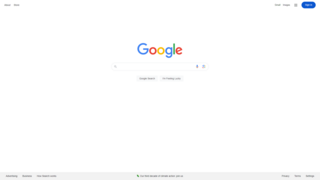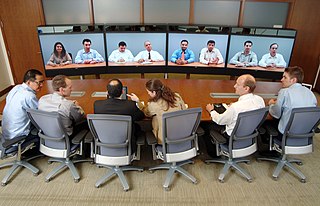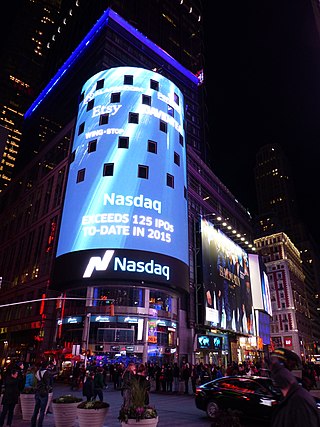
Google Search is a search engine operated by Google. It allows users to search for information on the Web by entering keywords or phrases. Google Search uses algorithms to analyze and rank websites based on their relevance to the search query. It is the most popular search engine worldwide.

Digital art refers to any artistic work or practice that uses digital technology as part of the creative or presentation process. It can also refer to computational art that uses and engages with digital media. Since the 1960s, various names have been used to describe digital art, including computer art, electronic art, multimedia art, and new media art.

Telepresence is the appearance or sensation of a person being present at a place other than their true location, via telerobotics or video.
New media are communication technologies that enable or enhance interaction between users as well as interaction between users and content. In the middle of the 1990s, the phrase "new media" became widely used as part of a sales pitch for the influx of interactive CD-ROMs for entertainment and education. The new media technologies, sometimes known as Web 2.0, include a wide range of web-related communication tools such as blogs, wikis, online social networking, virtual worlds, and other social media platforms.

MP3.com was a website operated by Paramount Global publishing tabloid-style news items about digital music and artists, songs, services, and technologies. It is better known for its original incarnation as a legal, free music-sharing service, named after the popular music file format MP3, popular with independent musicians for promoting their work. That service was shut down on December 2, 2003, by CNET, which, after purchasing the domain name, established the current MP3.com site.

Coined in 1987, the term Knowledge Navigator described a future computing system and how people might use it to navigate worlds of knowledge. In a sense, the user is actually the “Knowledge Navigator,” though the term often refers to the system’s primary interface, a tablet computer. That part often stands for the whole system. The term is also the title of an Apple “vision video.” The concept was described by former Apple Computer CEO John Sculley and John A. Byrne in their book, Odyssey: Pepsi to Apple.
“A future-generation Macintosh, which we should have early in the twenty-first century, might well be a wonderful fantasy machine called the Knowledge Navigator, a discoverer of worlds, a tool as galvanizing as the printing press. Individuals could use it to drive through libraries, museums, databases, or institutional archives. This tool wouldn't just take you to the doorstep of these great resources as sophisticated computers do now; it would invite you deep inside its secrets, interpreting and explaining—converting vast quantities of information into personalized and understandable knowledge.”
Alternative media are media sources that differ from established or dominant types of media in terms of their content, production, or distribution. Sometimes the term independent media is used as a synonym, indicating independence from large media corporations, but generally independent media is used to describe a different meaning around freedom of the press and independence from government control. Alternative media does not refer to a specific format and may be inclusive of print, audio, film/video, online/digital and street art, among others. Some examples include the counter-culture zines of the 1960s, ethnic and indigenous media such as the First People's television network in Canada, and more recently online open publishing journalism sites such as Indymedia.

Vizrt, short for Visualization in Real-Time or Visual Artist, is a Norwegian company that creates content production, management, and distribution tools for the digital media industry. It's products includes applications that create real-time 3D graphics and maps, visualised sports analysis, media asset management, and single workflow solutions for the digital broadcast industry.
Answers.com, formerly known as WikiAnswers, is an Internet-based knowledge exchange. The Answers.com domain name was purchased by entrepreneurs Bill Gross and Henrik Jones at idealab in 1996. The domain name was acquired by NetShepard and subsequently sold to GuruNet and then AFCV Holdings. The website is now the primary product of the Answers Corporation. It has tens of millions of user-generated questions and answers, and provides a website where registered users can interact with one another.

Web conferencing is used as an umbrella term for various types of online conferencing and collaborative services including webinars, webcasts, and web meetings. Sometimes it may be used also in the more narrow sense of the peer-level web meeting context, in an attempt to disambiguate it from the other types known as collaborative sessions. The terminology related to these technologies is exact and agreed relying on the standards for web conferencing but specific organizations practices in usage exist to provide also term usage reference.

The Nasdaq MarketSite is the commercial marketing presence of the Nasdaq stock exchange. Located at Times Square in the Midtown Manhattan neighborhood of New York City, it occupies the northwest corner at the base of the 4 Times Square skyscraper.
onedotzero is a contemporary digital arts organisation based in London that aims to promote new work in moving image and motion arts. The organisation conducts public events, artist and content development, publishing projects, education, production, creative direction, and related visual art consultancy services.
Technology integration is defined as the use of technology to enhance and support the educational environment. Technology integration in the classroom can also support classroom instruction by creating opportunities for students to complete assignments on the computer rather than with normal pencil and paper. In a larger sense, technology integration can also refer to the use of an integration platform and application programming interface (API) in the management of a school, to integrate disparate SaaS applications, databases, and programs used by an educational institution so that their data can be shared in real-time across all systems on campus, thus supporting students' education by improving data quality and access for faculty and staff.
"Curriculum integration with the use of technology involves the infusion of technology as a tool to enhance the learning in a content area or multidisciplinary setting... Effective technology integration is achieved when students can select technology tools to help them obtain information on time, analyze and synthesize it, and present it professionally to an authentic audience. Technology should become an integral part of how the classroom functions—as accessible as all other classroom tools. The focus in each lesson or unit is the curriculum outcome, not the technology."

User-generated content (UGC), alternatively known as user-created content (UCC), emerged from the rise of intelligent web services which allow everyday users to create content, such as images, videos, audio, text, testimonials, and software and interact with other users. Online content aggregation platforms such as social media, discussion forums and wikis by their interactive and social nature, no longer produce multimedia content but provide tools to produce, collaborate, and share a variety of content, which can affect the attitudes and behaviors of the audience in various aspects. This transforms the role of consumers from passive spectators to active participants.
Mobile local search is a technology that lets people search for local things using mobile equipment such as mobile phones, PDAs, and other mobile devices. Mobile local search satisfies the need to offer a mobile subscriber spontaneous access to near-position services and information such as businesses, products, events, restaurant, movie theatre or other local information. Mobile local search is the search and discovery of persons, places, and things within an identifiable space defined by distinct parameters. These parameters are evolving. Today they include social networks, individuals, cities, neighborhoods, landmarks, and actions that are relevant to the searcher's past, current, and future location. These parameters provide structure to vertically deep and horizontally broad data categories that can stand-alone or are combined to comprise searchable directories.
Sharon Grace is an American artist, currently a Professor Emeritus at the San Francisco Art Institute, who is known for initiating the use of many forms of electronic media based in audiovisual technology. Since 1970, Grace has worked with telecommunications as art, embedding interactive video and speech recognition in her work including video installation, electronic synthesis, interactive digital systems, and sculpture in stone and steel.
Organized and hosted by the Global Risk Forum The International Disaster and Risk Conference IDRC is a global gathering of experts for risk reduction, disaster management, and climate change adaptation. IDRCs are held as a biennial conference in Davos, Switzerland and complemented every other year with regional conferences hosted in different regions of the world and endorse the UNISDR Global Platform meetings.

Masa Israel Journey was established in 2004 by the Jewish Agency and the Government of Israel. Dedicated to its mission, Masa offers young Jewish adults from the diaspora transformative experiences in Israel. Masa's commitment to fostering personal and professional growth, combined with cultural exchange, has proven them as pioneers in the realm of immersive Israel experiences, spanning from 4 week to 10 month programs for ages between 16-50.

An interactive urinal is a device that allows users to play video games or control interactive displays while urinating. Several designs have been produced to date, usually comprising a urinal fitted with a pressure sensor to measure the strength and position of the urine flow and an LCD screen mounted above the urinal to provide animated graphics.
Global citizenship education (GCED) is a form of civic learning that involves students' active participation in projects that address global issues of a social, political, economic, or environmental nature. The two main elements of GCE are 'global consciousness'; the moral or ethical aspect of global issues, and 'global competencies', or skills meant to enable learners to participate in changing and developing the world. The promotion of GCE was a response by governments and NGOs to the emergence of supranational institution, regional economic blocs, and the development of information and communications technologies. These have all resulted in the emergence of a more globally oriented and collaborative approach to education. GCE addresses themes such as peace and human rights, intercultural understanding, citizenship education, respect for diversity and tolerance, and inclusiveness.









